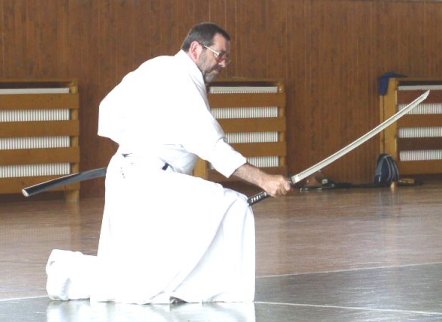|
Chinte
Chinte (珍手) (Japanese: "Rare Hand" or "Unusual Hand") is a kata practiced in Shotokan, Shito-ryu and in Okinawan Shorin-ryu Kyudokan. It is a very old kata originating from China. Its mixture of standard movements and rarely seen techniques, vestiges of ancient forms, give this kata a special appeal. Particularly dynamic, with its alternating strong and slow passages, Chinte is unique also in the presence of a number of circular techniques, despite the preference in Shotokan karate for linear movements. It is a kata of close-distance self-defense techniques. The somewhat peculiar closing movements allude to the absorption of the power of the waves by the sand, which is a symbol of the return to tranquility after the violent storm. Some believe the final three movements of the Shotokan version, a series of backwards hops, were added to bring the kata back to the original starting place in order to facilitate competition, because they are not present in the other versions of the ... [...More Info...] [...Related Items...] OR: [Wikipedia] [Google] [Baidu] |
Shotokan
is a style of karate, developed from various martial arts by Gichin Funakoshi (1868–1957) and his son Gigo (Yoshitaka) Funakoshi (1906–1945). Gichin Funakoshi was born in Okinawa and is widely credited with popularizing "karate do" through a series of public demonstrations, and by promoting the development of university karate clubs, including those at Keio, Waseda, Hitotsubashi (Shodai), Takushoku, Chuo, Gakushuin, and Hosei. Funakoshi had many students at the university clubs and outside dojos, who continued to teach karate after his death in 1957. However, internal disagreements (in particular the notion that competition is contrary to the essence of karate) led to the creation of different organisations—including an initial split between the Japan Karate Association (headed by Masatoshi Nakayama) and the Shotokai (headed by Motonobu Hironishi and Shigeru Egami), followed by many others—so that today there is no single "Shotokan school", although they all b ... [...More Info...] [...Related Items...] OR: [Wikipedia] [Google] [Baidu] |
Kata
''Kata'' is a Japanese word ( 型 or 形) meaning "form". It refers to a detailed choreographed pattern of martial arts movements made to be practised alone. It can also be reviewed within groups and in unison when training. It is practised in Japanese martial arts as a way to memorize and perfect the movements being executed. Korean martial arts with Japanese influence (hapkido, Tang Soo Do) use the derived term ''hyeong'' (hanja: 形) and also the term ''pumsae'' (hanja: 品勢 hangeul: 품새). Kata are also used in many traditional Japanese arts such as theatre forms like kabuki and schools of tea ceremony (''chadō''), but are most commonly known in the martial arts. Kata are used by most Japanese and Okinawan martial arts, such as iaido, judo, kendo, kenpo, and karate. Background Kata originally were teaching and training methods by which successful combat techniques were preserved and passed on. Practising kata allowed a company of persons to engage in a strug ... [...More Info...] [...Related Items...] OR: [Wikipedia] [Google] [Baidu] |
Self-defense
Self-defense (self-defence primarily in Commonwealth English) is a countermeasure that involves defending the health and well-being of oneself from harm. The use of the right of self-defense as a legal justification for the use of force in times of danger is available in many jurisdictions. Physical Physical self-defense is the use of physical force to counter an immediate threat of violence. Such force can be either armed or unarmed. In either case, the chances of success depend on various parameters, related to the severity of the threat on one hand, but also on the mental and physical preparedness of the defender. Unarmed Many styles of martial arts are practiced for self-defense or include self-defense techniques. Some styles train primarily for self-defense, while other combat sports can be effectively applied for self-defense. Some martial arts train how to escape from a knife or gun situation or how to break away from a punch, while others train how to attack. To ... [...More Info...] [...Related Items...] OR: [Wikipedia] [Google] [Baidu] |
Karate
(; ; Okinawan language, Okinawan pronunciation: ) is a martial arts, martial art developed in the Ryukyu Kingdom. It developed from the Okinawan martial arts, indigenous Ryukyuan martial arts (called , "hand"; ''tii'' in Okinawan) under the influence of Chinese martial arts, particularly Fujian White Crane. Karate is now predominantly a striking art using Punch (combat), punching, kicking, knee (strike), knee strikes, elbow strikes and open-hand techniques such as Knifehand strike, knife-hands, spear-hands and palm-heel strikes. Historically, and in some modern styles, grappling, throws, joint locks, restraints and kyusho-jitsu, vital-point strikes are also taught. A karate practitioner is called a . The Empire of Japan annexed the Ryukyu Kingdom in 1879. Karate came to mainland Japan in the early 20th century during a time of migration as Ryukyuans, especially from Okinawa, looked for work in the main islands of Japan. It was systematically taught in Japan after the Taishō ... [...More Info...] [...Related Items...] OR: [Wikipedia] [Google] [Baidu] |



